
In the meantime the loading had not stopped either. Slowly but surely the ship was filled with timber, with our heartfelt approval because it improved our ability to stay afloat. I think we spent a fortnight loading after we were told of our next destination.
We were ordered to go to ‘Abadan’ in the north of the Persian Gulf. The first port of call was going to be Colombo on the Island of Ceylon (now called Sri-Lanka).This became a fairly long trip, going along the southern side of Java and the west Coast of Sumatra. The route was mostly set by the British Royal Navy, because they were aware of the latest maritime situation. Our people on the bridge would have preferred to have skirted these islands at a much greater distance. Luckily our trip went well. We had a number of rifles on board left over from previous passengers. We used these to amuse ourselves by shooting at bottles we had thrown overboard (empty of course). This was a big wash-out because nobody ever hit one. Heaps of noise but few results. It broke the monotony of standing watches on such a long journey.
Yet it did not remain without any incidents. The day before we were to arrive in Colombo we were startled by the sounding of the alarm. Everybody was on his post In the blink of an eye. It was an aircraft that could not be identified because it was flying at too great a distance circling our ship. Again it was too small to be dangerous. We were, however, aware of a Japanese fleet that was making the Indian Ocean unhealthy but that was too far away from our position. Nevertheless the plane’s circles became smaller and smaller and everyone had the same thought; ‘Let’s down with that plane!’.  When indeed the machine was coming so close that it was wthin firing range the Captain ordered the crew to fire. The trigger-happy gunners did not wait for a second command and fired away. After using up two tins of ammo, the plane turned around and disappeared out of sight, not before we had all noticed that it had British markings!! The fact that the aircraft was still flying did not say much for our ability as gunners. The quiet after the shooting was so intense that we very clearly heard the voice of the lookout in the crowsnest, who in no uncertain and not very complimentary terms swore at the crowd on the bridge that they all had nearly killed him during the shootout at the aircraft. He was immediately ordered to come down which was not easy because he was shaking like a leaf. When he finally arrived on the bridge the captain apologized, gave him a bottle of Dutch Gin and told him to go ‘home’ and take the day off.
When indeed the machine was coming so close that it was wthin firing range the Captain ordered the crew to fire. The trigger-happy gunners did not wait for a second command and fired away. After using up two tins of ammo, the plane turned around and disappeared out of sight, not before we had all noticed that it had British markings!! The fact that the aircraft was still flying did not say much for our ability as gunners. The quiet after the shooting was so intense that we very clearly heard the voice of the lookout in the crowsnest, who in no uncertain and not very complimentary terms swore at the crowd on the bridge that they all had nearly killed him during the shootout at the aircraft. He was immediately ordered to come down which was not easy because he was shaking like a leaf. When he finally arrived on the bridge the captain apologized, gave him a bottle of Dutch Gin and told him to go ‘home’ and take the day off.
In the port of Colombo we took in the much needed provisions. The Captain went ashore to visit the agent and Admiralty House to discuss the route to be followed to Abadan. Here he heard much to his consternation that the pilot in the aircraft they had shot at, had been hit in the arm by a bullet. The Captain immediately went to the hospital to visit the victim and shake his healthy hand, to offer his apologies and offer him an authentic bottle of Bols gin. We all hoped that he would have enjoyed his drink in good health. The visit to Colombo did not last long and it was not long before we were in the open sea again.
Without any difficulties we arrived at the entrance of the Persian Gulf, the Strait of Ormuz. To our great surprise this was guarded by a small warship with the familiar contours of a floating clothes iron. Yes it was the gunboat Hr Ms ‘Soemba’. As soon as she recognised us the signal lamp got working. First to welcome us and then without further ado they asked: ‘Have you still got any BEER?’ The need must have been very great to make this cry for help across this very calm lake where the well known and by sailors detested Persian heat had already started to make itself felt.In this area the war had revealed itself in a manner for which the crew of the Soemba had never had any practice.Our Captain, like our crew, having had the experience of many war zones, understood exactly the position of the people on board the little warship. He warned the engine room to prepare to stop. When the engines have been running at top speed they are very hot and are cooled by cold seawater. It takes about half an hour to bring the engines back to an acceptable temperature which is safe to run them slowly for maneuvering without doing any damage. The Captain sympathized with the crew on the Soemba, particularly with the plates of spicy nasi-goring and other delicious dishes. Pea and Ham soup was served on our ship in tropical heat as well as in artic cold. In this situation The Royal Dutch Navy was without the required quenching water which was nothing short of a culinary disaster. A good number of crates of beer was brought out of our cold room and stacked on deck on the leeward side of the ship.From the Soemba which in the meantime had drawn quite close, a small rowboat was put in the water and, yes, you remember the ritual in Oosthaven, the same scene was played out here again. With the sailor spick and span etc etc arrived the ‘Commandant’ in style at the bottom of the quickly installed companion way. He was welcomed by the first officer who accompanied him onto the bridge where our Captain greeted him warmly. The dinghy was tied down at the bottom of the steps and the sailor settled down to await the return of his Commandant. What exactly happened I cannot remember but orders were given to the engine room to start the ship moving slowly ahead. Since it was not my watch I was on deck and stood by the railing idly looking down and watched the sailor at his leisure light a cigarette and take an enormously long pull which he totally inhaled and at length exhaled again. I thought: ‘Anybody else would have choked on that. I bet he chews tobacco as well’ These idle and boring thoughts were immediately dispelled when I saw the ship moving slowly and as a result towing the dinghy tied to the companion way along with it.I could see what was about to happen: The rope was a little too long, pulling the bowof the little boat lower in the water. The sailor went up front to shorten the rope but with the shift in weight the bow went right under water and with the moving of our ship filling the whole boat.The sailor desperately hung on to the rope while his nice white starched cap slowly floated away. Luckily an officer on the bridge was looking down and rang the telegraph to stop the ship.The sailor was immediately pulled on to the companion ladder but the rope tied to the dinghy broke and down went the little boat.Because of all the noise and shouted commands the Captain and his guest arrived on the bridge and surveying the scene, the Captain opened his mouth, not in surprise but in anger, which resulted in the longest stream of words I have ever heard but cannot write down here.To cut a long story short, our motorized lifeboat was lowered, the crates of beer loaded as were the Commandant and the sailor and away puttered the boat to the Soemba to unload its cargo. After the lifeboat’s return it was hoisted back into the davits, the telegraph was put on full speed ahead and that was the last we saw of the Soemba. Nevertheless the regard the Royal Navy and the Merchant Marine had for each other was kept intact. Ha, Ha, Ha.
The trip through the Persian golf ran like clockwork with increasingly higher temperatures. The only occasion of any note occurred while I was looking overboard and I saw all of a sudden an enormously large sting ray, a manta ray I thought, that was swimming alongside the ship. A big one with a diameter of at least two and a half metres, which slowly and graciously moved the end of her- let’s call them ‘wings’ trying to keep up with the ship. It was a really beautiful and memorable sight. We arrived in Abadan shortly after and tied up at the wharf.
The period we were in Abadan was very busy for the crew in the engine room with the ‘pulling’ of one of the cylinders of one of the main engines. Normally this takes one day. The temperature on deck was about 40 degrees Celsius. In the engine room it was considerably more. The shore workers there had a siesta from 12.00 till 16.00 hours because of the heat, it was just too warm. This did not apply to the engine room crew; they had to keep going come what may. This work was always done in a harbour during the day; it was the same here. You could no longer see us sweat, it dried up as soon as it came through your skin. Slowly but surely a thin layer of salt formed on your face. As soon as we entered the Gulf we were given salt tablets to swallow and that was now coming out. It was really too much to bear but we had to do it!
On a Sunday (a free day) I with a few other men hired a taxi to visit the town of Basra situated a little further away. Halfway there we saw a few large shops which also had a type of terrace where one could buy (alcohol free) drinks. After consuming a few cool drinks we went into the shop and much to our surprise we saw on the shelves large tins with ‘Van Houten’ cocoa (a popular Dutch treat). Not to be had anywhere else in the world but here available in the middle of nowhere.In Basra we went to the flicks, where we sat in a box with six loose chairs. One reached this box by three large steps with at the top a swing door. Halfway through the film one of the fellows pushed his chair back with the result that he made a back-flip and with a lot of noise landed in the corridor. The theatre attendants rushed in and with a look of pity could not suppress their smiles. We of course were laughing our heads of. This was our only adventure in bloody hot Basra.
When the ship was unloaded we filled our oil tanks (there was plenty of that there) and departed with Durban in South Africa as our destination. It could not be quick enough for us. The temperatures were becoming too much for us. At the entrance to the gulf we again passed the Soemba and as a maritime courtesy we dipped our flags.
It was a long distance to Durban but now, with the ship empty, we went along very well, the weather was good and it was like sailing in peacetime. Yet we knew and were well aware that on the East coast of Africa and around Capetown German long range U-Boats were operating and had torpedoed a number of ships. We were still a long way from there so were not too worried.
The only incident happened one night when we were sailing through the Strait of Mozambique. We encountered a submarine on the surface that passed us going in the opposite direction at a distance of no more than forty metres. It was pitch dark and I have a feeling that on both sides a few hearts stopped. Nearly a near-miss between two vessels moving at full speed. It was not identified and did not turn around because we did not see him again. It was a distinct advantage to be on board a ship that could outrun a surfaced submarine.
And so we arrived again in Durban where we made a few repairs and loaded some more provisions, water and oil and we were ready to set sail again. This time we were ordered to sail to Trinidad on the other side of the Atlantic Ocean.
<< previous chapter ——————————————————————next chapter >>

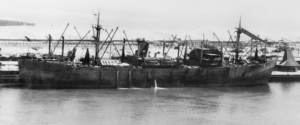
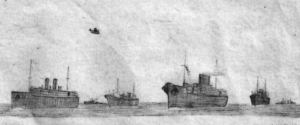
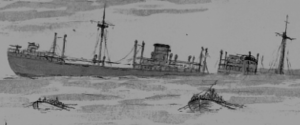
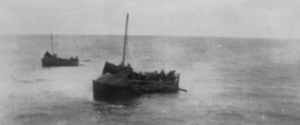
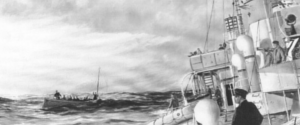
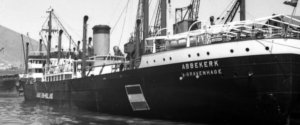




I remember vividly the incident of the British plane being fired at by the Abbekerk, seeing the tracer bullets arcing into the sky. I was 10 years old at the time and was traveling with my Mother from Fremantle to Columbo to rejoin my Father who had escaped from Singapore Mother and I had been evacuated from Singapore on the Orion I remember there was another incident when we arrived at Columbo in the evening The ship ran into the anti submarine nets and flares emerged from the water to illuminate us for the benefit of shore batteries which fortunately did not fire at us Thanks to the Abbekerk we survived the voyage and thanks to the crew who gave me a birthday cake on the 12th April